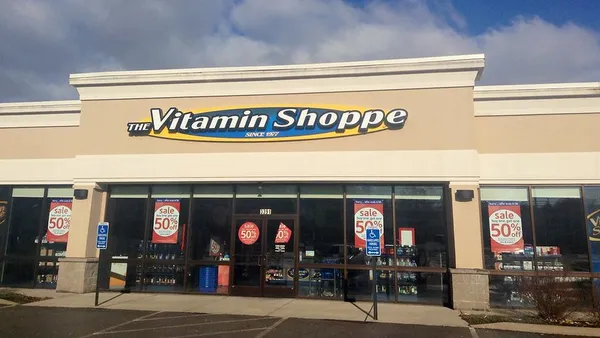Dive Brief:
-
Urban Outfitters Inc., which includes apparel and home goods brands Anthropologie, Bhldn, Free People and Terrain as well as Urban Outfitters brands and a food and beverage division, on Tuesday reported that fourth quarter net sales rose 2% over the same quarter last year to a record $1.03 billion, driven by $19 million in sales from new Vetri Family Restaurants locations.
-
Overall Q4 same-store sales were flat, Urban Outfitters said. By brand, same-store sales rose 2% at Urban Outfitters and 1% at Free People; Anthropologie dropped 3%. E-commerce sales outperformed stores, with double-digit sales growth driven by increases in sessions and conversion rate that more than offset a decrease in average order value. In addition, Urban Outfitters' wholesale unit experienced 13% sales growth over the second half of the year and is on pace to grow 10% this year.
-
Urban Outfitters' direct-to-consumer and wholesale channels produced compound annual growth rates in the high teens (as opposed to physical store CAGR in the low single digits), a trend the company believes will continue, meaning investments will go online, too, executives told analysts. In addition, Urban Outfitters has reorganized its digital teams and has hired Dave Hayne to fill the newly-created role of chief digital officer.
Dive Insight:
Urban Outfitters brands have some of the most compelling physical store approaches in retail, presenting almost a lifestyle for sale rather than apparel, accessories and home goods per se. But even its brands are struggling with declining traffic into stores, executives said Tuesday. Moreover, its various units have successfully translated their respective branding, emotional pull and core customer relationships to the online realm, with images and fonts that match each brand’s vibe. Urban has improved the nuts and bolts effectiveness of its sites as well.
It has more to do on that front, however, especially with the reality that digital sales are increasing in volume and importance, but Urban Outfitters also has improvements to make to some its stores, says GlobalData Retail managing director Neil Saunders.
“[Urban Outfitters' Q4 results were] driven by online sales and offset by a fall in store-based revenue,” Saunders said in an email to Retail Dive. “Although this leaves the top line number looking reasonable, it has a damaging impact on the bottom line where, partly thanks to higher fulfillment costs, net income dropped by 11.8%. This has been a trend across this fiscal year and, unfortunately, it shows no sign of dissipating as the proportion of sales made online continues to increase. In our view, while Urban has done a good job of investing in its website — making it faster and easier to use — it still has much more work to do in making its store fleet more productive.”
On a conference call with analysts Tuesday, Urban Outfitters founder and CEO Richard Hayne said that the company is not abandoning its stores, with plans to open 19 new locations across all brands. It also will close seven due to lease expiration and will avoid signing long-term leases in anticipation that rents will fall as North America corrects its problem of being over-stored. Even so, Urban Outfitters' emphasis is decidedly on the online channel. Also vexing the company and complicating how it balances it online/offline mix: The effect such adjustments have on sales and margins.
“This would be fine if the increase in direct-to-consumer sales were wholly additive, but they’re not,” Hayne told analysts. “Digital shopping is partially replacing store shopping and thus is negatively impacting store traffic and store generated sales. Add to that the fact that the U.S. market is oversaturated with retail space and far too much of that space is occupied by stores selling apparel. Retail square feet per capita in the United States is more than six times that of Europe or Japan. And this doesn’t count digital commerce.”
Hayne also described a holiday period marked by wild swings that seemed outside regular influences like the weather. “I would characterize results during this year's fourth quarter, especially the holiday season, as both disappointing and highly unusual,” he said, according to a transcript from Seeking Alpha. "Within the quarter, two distinct periods appeared. Comps were up nicely in the month of November. All three brands enjoyed a fantastic start of the holiday season by driving double-digit comp sales gains on both Black Friday and Cyber Monday. Things were looking very good. Then came December, store traffic and overall demand in North America at all three brands evaporated for several weeks at the beginning of December. More normal demand returned only as Christmas and Hanukkah drew near. Demand remained normal immediately after the holidays but fell back again once the New Year began. I can't recall having ever seen a quarter with such wild and wide fluctuations.”
Furthermore, January is no longer a mop-up month where brands can satisfy themselves with clearing inventory through markdowns, Hayne said. “[The customer] wants new fashion and the brand didn't offer her enough of it. One of the Urban brands big wins in the quarter and the year came from its marketing efforts. During the quarter marketing activity on a year-over-year basis drove 23% more sales and generated 56% more incremental margin.”
Buying the Vetri pizza chain in 2015 has paid off, however: Expanding those dining efforts and continuing store layout and merchandising improvements plus “fixing Anthropologie” will be key to Urban Outfitters' performance this year, Saunders said.
Urban Outfitters also has particular opportunities in certain categories, especially at Free People. Beauty same-store sales increased by double digits in the quarter, and the company is exploring how to leverage that growth, possibly by introducing in-house brands. In addition, Q4 revenue from Free People’s “movement” category, which includes yoga and fitness apparel as well as athleisure, grew 71%. That merchandise is now being sold at spas, yoga studios, gyms and fitness centers as well as through Free People own channels. “We believe the movement brand has very exciting opportunities and could drive substantial future revenue growth,” Hayne said.













